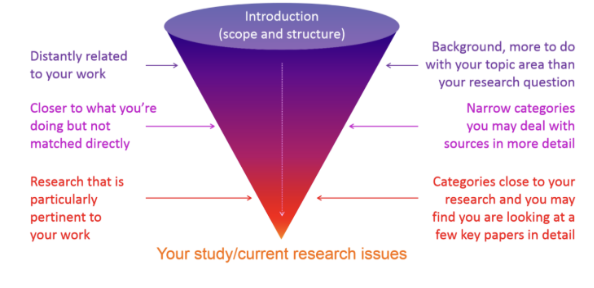[OPST 195]: Lec. 3 - Searching and Reviewing the Literature
1/42
There's no tags or description
Looks like no tags are added yet.
Name | Mastery | Learn | Test | Matching | Spaced |
|---|
No study sessions yet.
43 Terms
explores and evaluates literature on a specific topic
determines what is known on a topic and how well this knowledge is established
tells what had already been done
literature review
literature review in research
literature reviews is a generic term for published materials
Examples of Literature Reviews
scoping review
mapping review
systematic review
type of knowledge synthesis that maps key concepts, sources, and evidence in a broad research area to give a preliminary overview of the nature and extent of existing literature
Scoping review
a systematic and transparent method that categorizes existing evidence to show what research exists, where gaps remain, and to guide future reviews or primary studies
mapping review
a rigorous method of minimizing bias by comprehensively identifying, appraising, and synthesizing studies on a specific topic, often including a meta-analysis to combine data into a single summary estimate
systematic review
Importance of literature review
contributes to almost all steps
serves as foundation
of a research project
Literature review process
Identify question
Search literature
Read critically
Synthesize
Write review
Conducting a literature search
involves the first 2 steps of the lit review process (identofy question, search lit)
Principles of lit. search
systematic
explicit
rigorous
thorough
plan your search strategy
sytematic
document your actual searching process all throughout
explicit
adhere to rules you initially set
rigorous
cover almost all relevant studies
thorough
Tools
search engines: information retrieval systems: pubmed, google scholar, ovidsp
bibliographic databases: contain lists of citations of published and unpublished references
reference management software: any software product used for storage and retrieval of bibliographic records: mendeley, zotero, endnote
Literature Review Steps
identify search terms
plan/select search strategy
implement and adjust strategies
retrieve and organize literature
analyze research topic, identify key concepts
pico framework
step 1: identify search terms
PICO
patient/population
intervention (exposure
comparison
outcome
when doing this, consider: synonyms, hypernyms, hyponyms, acronyms, technologica differences
deside scope of review
consider comprehensiveness and practicality
identify databases
step 2: plan/select search strategies
national library of medicine’s controlled vocabulary thesaurus for indexing article for the medline/pubmed database
MeSH (medical subject headings)
BOOLEAN LOGIC & RELATED OPERATORS: And
retrieves articles that contain all the terms
narrows down the search
BOOLEAN LOGIC & RELATED OPERATORS: Or
retrieves articles with any of the terms
broadens the search
BOOLEAN LOGIC & RELATED OPERATORS: Not
eliminates the articles containing the second term
narrows down the search
Other operators: ()
parentheses: grouping operator
groups terms/sub-queries togehter
those inside the parentheses are evaluated first before boolean operators
Other operators: ““
quoatation marks: exact phrase search
exact phrase/sequence of words
Other operators: *
asterisk: truncation or wildcard operator
used as a truncation symbol to retrieve variation of a root word by replacing zero or more characters at the end of the word congress*=congressional, congressman
for keyword search, applies to titles and abstracts or articles
prompted by the number of hits from the initial hits
can be narrow search through filters or broaden
step 3: implement and adjust strategies
ways to broaden the search
related articles search
ancestral search: tracking down references of an article
citation search
gray literature: looking at unpublished/published in non-commercial form
if cant access, email the first author of the article
discriminate between relevant and irrelevant articles
document the search
step 4: retrieve and organize lit.
Crtitical reading strategies
identify type of source
get ng info about the study
skim the abstract, headings, and conclusion; read only what you need
ask questions before, during, reading
take note of useful info
critically appraise relevant studies
Note-taking strategies
charting method
sentence method
cornell method
mapping method
list of points, create column for each one, note down references in each column
charting method
write down ideas as a sentence
sentence method
in one column write your own summary, on the other, write your own assessment and critique
cornell method
write down key concepts and terms, relate them
mapping method
journal article structure
brief and concise
1-2 pages
assumes reader has some knowledfe
only cite what is pertinent
emphasize pertinent findings
master’s thesis structure
comprehensive
20-40 pages
exhaustive review
present chornological progressions of knowledge

funnel model
introduce problem first, then set contect, analyze past research, then narrow to the one closes to your own
Topic/Problem/Rationale qs
a. What made you think of doing
the study?
b. What makes this problem
worth solving?
c. Must be straight to the point.
Known qs
a. What has already been done
to solve the problem?
b. In relation to this, what sort of
questions have already been answered
Gap qs
a. What sort of questions have
yet to be answered?
b. What questions may not have
been adequately answered by
previous studies?
Primary sources
■ Government reports,
Conference proceedings
■ Original artwork, Poems,
Photographs
■ Speeches, letters, memos,
interviews
Secondary sources
■ Literary criticism and
interpretation
■ Reviews of law and legislation
■ Political analyses and
commentaries